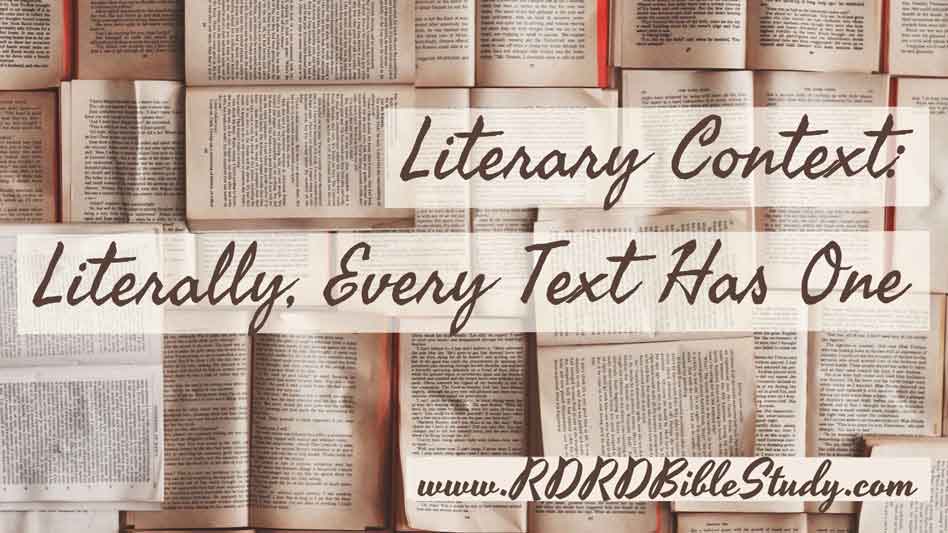Literary Context: Literally Every Text Has One
Any time you read one of the following:
- Newspaper
- Shakespearean poetry
- Harry Potter book
- Harry Truman biography
- Algebra textbook (by force)
- FB post
Whether you realize it or not—your mind automatically makes a mental shift to “hear” what you have learned to “hear” from these reading materials. This mental shift happens subconsciously based on your experience with the literary context of each type of writing.
In general, two sorts of “mental shifts” occur related to literary context. Those pertaining to 1) genre, and 2) structure of language.
1) Genre
Instinctively the reader anticipates a certain form of writing from the genres listed above:
- Newspaper – commentary surrounding news stories
- Harry Potter book – fictional book of Harry’s magically delicious adventures
- Harry Truman bio – a non-fiction book of a popular President’s life
- Algebra textbook – practical guide teaching mathematical symbols and their rules in ascending order of difficulty
- FB post – a totally random snippet from someone’s life and/or a cat video
2) Structure of the Language
Under the larger umbrella of genre, the reader also accepts variations of the written language, i.e. how sentences are formed, the meaning of words in sentences, formal, informal, abbreviations, etc.
- Harry Potter book – unusual words that aren’t in our vocabulary, but have meaning to wizards and witches
- Harry Truman Bio – a historical narrative describing the facts of someone’s life
- Algebra textbook – technical and questionably straightforward instructions for learning algebra
- Shakespeare – use of metaphor, similes, a turned phrase, 16th century English words and phraseology
- FB post – an informally written blurb which may or may not use colloquial language, correct spelling, and/or acronyms
So How Is This Relevant To Bible Study?
When it comes to the Bible, most people make a mental shift, as with other reading materials, to “hear” what they expect to hear from the Bible.
So far, so good.
The problem is that many times all 66 books are read using the same mental shift. However, the Bible itself contains multiple literary genres.
And it is translated from the Hebrew and Greek languages (and a little Aramaic).
And all 66 books were written over a long period of time, a long time ago.
God chose to reveal Himself over a period of many years, through people who lived in a particular time and culture.
God is lord. He rules history, when he reveals himself, He does so in space and time, in the contingent circumstances of history and culture. His words are clothed in the thought patterns of distinct historical and cultural contexts. E. J. Schnabel, “Scripture,” in New Dictionary of Biblical Theology, InterVarsity Press, 2000, 37-38.
Why Is Genre Important?
Genre supplies a road map for reading. Signs belonging to a certain genre notify the reader which direction to take in order to understand what is being read.
OT poetry uses parallelism, similes, acronyms, and many other poetic devices. NT letters have greetings and endings. Jesus’ parables provide shock value.
Imagine reading a Harry Potter book with the genre mindset of an algebra textbook—if a broom flies at a speed of 400 mph, and it take 5 minutes to get to Little Hangleton, from what distance did Harry’s journey start? (Excuse me, while I grab several Advil.)
Or imagine reading a biographical account of Harry Truman’s life with the mindset of an FB post—“FDR RIP” would seem trivial compared to the significant impact it had on Truman’s life and the United States.
As Vice President, Truman succeeded to the presidency on April 12, 1945, upon the death of Franklin D. Roosevelt.
Why Is Historical Context Important To Literary Context?
Since language, word meaning, and genres can change dramatically over a few decades, historical context also effects literary context.
Consider that Shakespeare lived from 1564-1616, approximately 400 years ago. Quite a contextual leap has to be made to understand his writings today.
Shakespearean literature uses metaphors, words no longer in vogue, etc. Experts in 16th and 17th century English Literature study literary devices from that period to better understand Shakespeare. Likewise, students of the Bible must scrutinize literary devices used in Scripture to better understand the Bible.
In the OT, the books of Joshua and Samuel may seem like comparable reading, but there is actually 400 years between Joshua and David. Not to mention the 3000-3500 year gap for us today.
Regardless of century or continent, ancient documents need to be studied according to genre and language structure within historical context. – RDRD Bible Study
Toxic Speculation Spills
When people read the entire Bible with the same general mindset, an odd sort of “genre mind meld” is produced. Add to this the modern habit of reading a few verses outside of their context. It’s like a clip from an upcoming TV show when someone makes a shocking statement. But in reality, the clip, in context with the language before and after it, has an entirely different meaning than it led viewers to believe. And usually, it is not shocking at all.Trying to understand or discuss the Bible—intelligently—without taking the genre and/or language structure into consideration, produces all kinds of hazardous interpretations, i.e. proof texts, of Scripture.
Hazardous?
Yes, hazardous. Even toxic. Toxic spills of speculation.
When only part of something is heard, like the TV clip, it sets the stage for misunderstanding and/or inferring wrong conclusions. This happens frequently in all writings, but seems to be especially prevalent when dealing with Scripture. When the Bible is involved, it’s as if all literary rules are tossed to the curb.
The #1 goal in Biblical interpretation is to find the theological principles that the author intended to communicate to his hearers/readers and then applying those same principles today (in whatever century today happens to be).
Determining authorial intention is how we get to the truth. Anything other than truth is hazardous. Hazardous waste is toxic. So are hazardous speculations.
Literary Context Need To Know
The best way to avoid toxic spills of speculation, aka interpretation, is to determine the context of a passage—historical, literary, and theological. As far as literary context goes, literally every text has one.
Literary context answers the question of 1) genre and 2) the meaning of words in relation to the surrounding text and language structure, within the genre
Literary Context Refers To The Following:
- Genre – style, form, and content
- Structure of the language, primarily including (but not limited to);
- Syntax – the study of the formation of sentences
- Semantics – the study of meaning
- Pragmatics – the study of language use
Literary context reminds us that
1) the Bible is literature. and
2) that words have meaning based on the surrounding text and the structure of the language.
If you have a love of literature and/or grammar, great! Otherwise, please do not let thoughts of assigned readings of Beowulf or The Unvanquished or ex-English teachers set your mind against doing literary context due diligence when studying the Bible.
Determine The Genre Then the Language Structure
The language structure varies based on genre. Joshua’s historical narratives, 1 Chronicles’ genealogies, and the poetry of the Psalms are all from the Hebrew language. But their genre guides the form that the language structure uses.
Literary Context Provides A Safeguard Against Pretexts
Memorize this and you will never go wrong:
A text without a context may be a pretext to a proof text.
Maybe I’m starting to sound like a broken record?
What Is Prextext and Why Is It Toxic?
- Pretext is a reason given in justification of a course of action that is not the real reason.
- Pretext is a false reason given for doing something. If you catch your mother going through your drawers, and she says she was just tidying up, cleaning was her pretext for snooping. (from www.Vocabulary.com accessed 4/24/2016)
A pretext is an interpretation of Scripture that appears valid, but in reality has been taken out of context, out of its surrounding text and language structure, and so yields an inaccurate interpretation. Literary Context provides a safeguard against pretext.
I Get Genre but “Language Structure” Sounds Vaguely Unfamiliar
Language, spoken or written, is the use of words in a structured and conventional way. For example, the structure of adjective use differs between the English and French languages.
In English, it is “black cat.”
In French, “le chat noiré.”
Even this brief example shows another difference; French assigns gender to nouns, so the noun is stated with its appropriate article.
As stated earlier, a basic principle of Biblical hermeneutics is that the intended meaning of any passage is the meaning that is consistent with its literary context. The context of any specific passage is what comes before and after it, i.e. how the sentence in that particular language is structured, i.e. black cat or le chat noiré, etc.
- Words only have meaning in sentences.
- Sentences have clear meaning in relation to the sentences before and after.
Or to put it another way:
- The context of a word is its sentence.
- The context of a sentence is its paragraph.
- The context of a paragraph is the paragraphs before and the paragraphs after.
- The context of a chapter is the surrounding chapters.
- The entire book, where a passage is located, is the main context.
- The entire Bible, is the largest literary context in which every passage must be understood.
For a more detailed breakdown of the relation and significance of these, see RDRD Bible Study post Circles of Contextual Study.
Bible Study Freebies As A Result Of Literary Context Analysis
Analyzing genre and structure of the language, i.e. the literary context, helps to determine authorial intention and concomitant to that, contemporary application. It’s not foolproof, but it does rule out absurd interpretations and applications. Absurdity is very toxic.
Literary Context also helps in other areas: 1) Word Meaning and Context; 2) Flow of Thought, and 3) Determining the Author’s Outline.
1) Word Meaning and Context
Determining the accurate meaning of words can be labor intensive, yet is also one of the most enriching parts of bible study.
Many words from the OT and NT have multiple meanings or a wide range of meanings. Literary context is the most trustworthy guide in determining the most precise meaning of a word.
That means that a single word can’t be interpreted by itself, but must be interpreted within the phrase, within the sentence, within the paragraph, etc. in which it occurs. Likewise, the phrase, sentence, and paragraph must be understood according to its natural meaning in the literary context in which it occurs, i.e. genre, language structure.
In this way, literary context guides the translation process.
This may sound like an abstract concept, but it really isn’t. Here is a practical example using John 16:7-11.
2) Flow Of Thought
Communication takes place by an author sharing a logical flow-of-thought where one thought leads to another. One statement prepares for the one that comes after, and that one prepares for the next, etc. A flow-of-thought is a series of related ideas that the author has organized to communicate something.
Asking “What’s the Point?”
As you look for the flow of thought, a helpful and important literary question to ask of every phrase, every sentence, every statement, and every paragraph is “What’s the point?” For example:
- What’s the point of this phrase in this sentence?
- What’s the point of this sentence after this sentence?
- What’s the point of this entire paragraph?
Ask “What’s the point?” multiple times.
Biblical authors communicate by a series of related statements, the operative word being “related.” Each sentence must be understood in light of other ideas conveyed by the context.
This is really common sense, the normal way people communicate.
Don’t throw out common sense when studying the Bible.
3) Author’s Outline
In this context, (bad) pun intended, “outline” means how separate parts of a passage are related to each other, even though their immediate context may be different.
In a bible study, the class may read chapter 1 on one Sunday, and chapter 2 the next Sunday, etc. However, most biblical books were intended to be read as a whole. The biblical writers edited sentences and paragraphs as part of a larger document.
Chapter And Verse Numbering
When you read your Bible today, each book appears to be broken down into individual pieces called verses, instead of logical units, similar to those found in an outline. But keep in mind that chapter and verse numbering were not in the original documents.
Though some verse numbering in the Hebrew Bible appeared early on, the standard division of verses was fixed by the Masoretic family about 900 AD. The chapter divisions came later in 1244.
A Parisian printer and publisher, Robert Estienne, added verses to the Greek NT in 1560 AD. The Geneva Bible of 1560 was the first English Bible to contain both chapter and verse divisions.
Chapter and verse divisions are extremely useful for finding passages as well as referring to a passage in sermons or discussions. But keep in mind that the chapter and verse division, (not to mention the paragraph headings) sometimes do not present an “outline” of contextually related passages, as the author intended, i.e. author’s outline, within the larger context of the book.
Though a chapter break was inserted after 2 Peter 1:21, in context, it is clearly related to the verses in 2 Peter 2:1-3, so most likely does not represent Peter’s exact outline. This doesn’t diminish Peter’s message. Instead the onus lies on the interpreter to find Peter’s outline.
Literary Context Summary
- Literary context reminds us that the Bible is literature.
- Literary context reminds us that words have meaning based on the surrounding text and the structure of the language.
- Literary context includes genre and the structure of the language within that genre.
- Genre is a heads up to what type of writing to expect.
- Literary context is done within the historical context.
- Literary context serves as a trustworthy guide in determining accurate meaning of words.
- Literary context helps the reader follow an author’s flow of thought.
- Literary context reveals the author’s outline of a passage.
- Literary context helps in avoiding toxic interpretations of a text, because it carefully steers the interpretation by following basic rules related to language.
Until next time –
The grace of the Lord Jesus Christ and the love of God and the fellowship of the Holy Spirit be with you all. 2 Corinthians 13:14
Working Some Literary Context on 2 Corinthians 13:14
RDRD ends each post with this wonderful Trinitarian prayer from Paul. But since this post is about literary context, well, it only makes sense to briefly demonstrate how much literary context informs the study of a passage.
Here goes–
the genre is 1st century letter, and the immediate passage begins in v. 11:
Finally, brothers, rejoice. Aim for restoration, comfort one another, agree with one another, live in peace; and the God of love and peace will be with you. 12 Greet one another with a holy kiss. 13 All the saints greet you. 14The grace of the Lord Jesus Christ and the love of God and the fellowship of the Holy Spirit be with you all. 2 Corinthians 13:11-14
The letter, or epistle, genre is an “occasional” document, meaning that its writing was occasioned by some circumstance(s). Letters end with a closing, replete with exhortations to the addressees. Paul normally includes the major themes of the letter in the closing.
After Paul left Corinth, the church experienced many conflicts. Informed of the Corinthian situation by church leaders, Paul apparently wrote a stinging rebuke concerning the conflicts. Because church members were upset over this rebuke, and confused over Paul’s seemingly indecisive travel plans, presents the occasion for Paul to write what we know as 2 Corinthians.
Letter closings normally contain greetings between church members and missionaries, notice of future travel plans, etc. But their purpose also figures prominently in what the author wants to leave “ringing in the ears” of his hearers as the letter ends.
The closing of 2 Corinthians tells us what is foremost on Paul’s mind regarding the Corinthian Church, themes he touched on throughout the letter: restoration, comfort, agreement, peace, and joy. (Literary Context proves it is not coincidental that 2 Cor. 1 speaks at great length about “comfort,” and that Paul’s closing includes “comfort”.)
Paul reminds and encourages the church: “hey, you are not in this alone; all the saints greet you. The saints are praying for you, they are with you in spirit, they are rooting for you.” By default, this includes Paul. Though he had to change travel plans and has not been able to visit the Corinthian Church again–making the stinging rebuke cause lots of toxic speculation regarding Paul’s actions toward them–on the contrary, he assures the church that he is praying for them and present with them in spirit.
And then in this beautiful reminder to the church of the ongoing collaboration of the Trinity in their midst
the grace of the Lord Jesus Christ (whose grace is sufficient for Paul, so certainly for the Corinthians, and whose power is made perfect in weakness, yes even the weakness of the Corinthians, their conflicts, their propensity to sin, their guilt, their sadness 12:7)
the love of God (Who, because of His love, in Christ reconciled the world to Himself, even while the Corinthians were sinners He did this, 5:19, so the Corinthians have been reconciled to God and now serve as God’s ambassadors)
and the fellowship of the Holy Spirit (where the Spirit of the Lord is there is freedom, and all believers, through the Spirit, behold the glory of the Lord and are being transformed into the same image, this from the Lord who is the Spirit, 3:17-18; all of the Corinthians are in a process of transformation, so restore the divisions, comfort and agree with one another, all are works in progress).
Wow. Ahhh the literary context… But even more, the grace of God in the love of the Lord Jesus Christ… What can compare?












